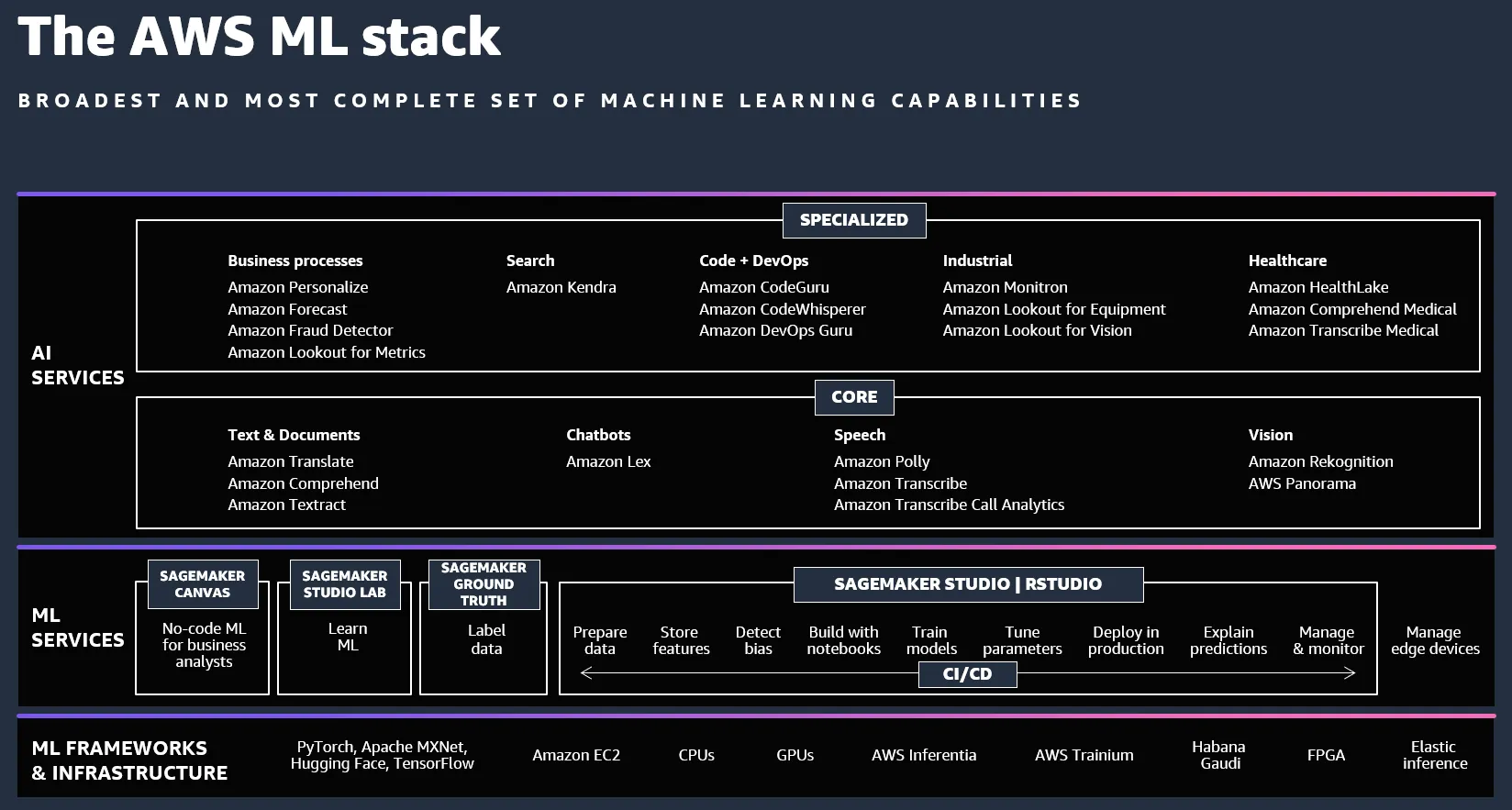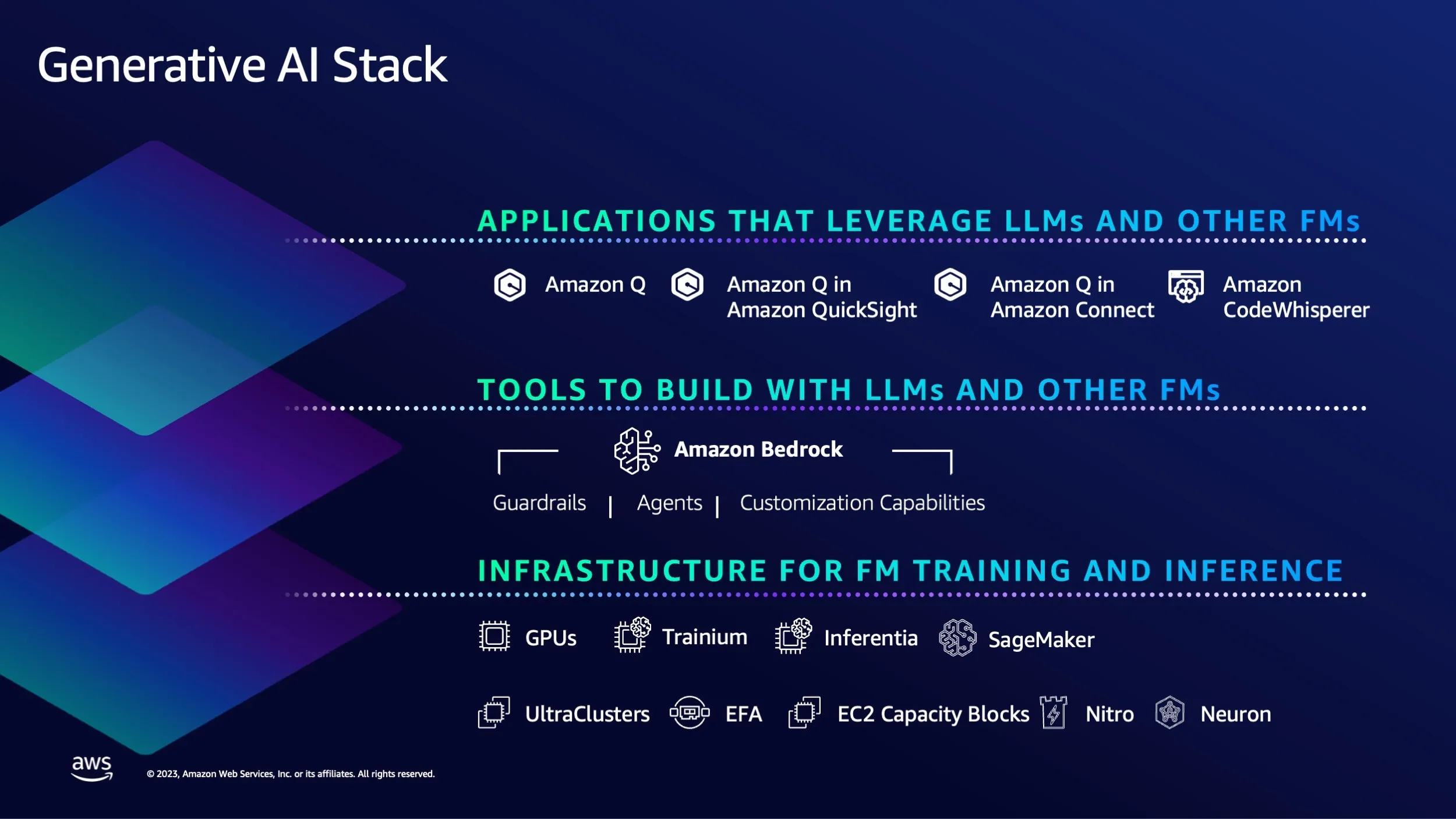Navigating the AI Landscape - Choosing the Right Tools
When to build and when to use prebuilt solutions.
Published May 9, 2024
In today’s tech-driven world, integrating Artificial Intelligence (AI) is a game-changer for businesses aiming to boost efficiency, streamline operations, and uncover new opportunities. But for those just dipping their toes into the AI waters – whether they’re newbie engineers, CEOs, or startup founders – there’s a common dilemma: “What kind of AI fits my needs?” By the end of this I hope to unravel the AI maze, with a special focus on AWS services, offering insights to help you pick the perfect tools tailored to your goals.
When it comes to diving into AI, businesses face a fork in the road: building AI capabilities from scratch or opting for ready-made AI solutions. Let’s break down the pros and cons of each path.
Creating AI solutions from the ground up gives businesses the freedom to craft algorithms that match their unique requirements. AWS has a rich array of services covering all facets of AI, like Amazon SageMaker and Amazon Bedrock for machine learning model development and deployment and a whole range of infrastructure options such as AWS Trainium and AWS Inferentia for training and inference.
- Customization - Tailor algorithms to fit your specific business needs.
- Cost-efficiency - Pay only for what you use, minimizing upfront costs.
- Learning opportunity - Engineers get hands-on experience and deeper insights into AI fundamentals.
- Expertise required - Building and maintaining AI solutions demands solid knowledge of machine learning and related tools.
- Time-consuming - From data preprocessing to model training and deployment, DIY AI projects eat up a considerable amount of time.
- Resource-intensive - You’ll need dedicated personnel and computational resources for development and upkeep.
Alternatively, businesses can opt for consumer-based AI products offered by AWS, such as Amazon Rekognition, Amazon Textract, and Amazon Translate, and even more recently Amazon Q Business, Amazon Q Developer and Amazon Bedrock knowledge base. These off-the-shelf solutions are designed to deliver out-of-the-box AI capabilities with minimal setup and configuration required.
- Accessibility - Easy-to-use APIs make integrating AI functionalities easy.
- Super quick deployment - Dive into AI applications without lengthy development cycles. [1]
- Scalability - AWS handles the infrastructure, ensuring seamless scalability as your needs grow.
- Limited customization - Pre-built products may not perfectly align with your specific business requirements, limiting flexibility.
- Cost considerations - While initial setup costs might be lower, long-term expenses can pile up based on usage.
[1] At the time of writing I sat with my Co-CEO and built an Amazon Bedrock Knowledgebase in 15 minutes to demonstrate this capability! (That included time to get a coffee whilst the data source synced!)
Historically, AWS have explained this idea using the term “The ML Stack” and more recently “The Gen AI Stack”. This has been their way of differentiating between these different levels or concepts. AWS have prided themselves in the past on being able to not only provide best in class development services, but also enabling builders and businesses to get started in an accelerated way.


These two diagrams and AWS Blog Posts above illustrate this point of difference, elegantly between “DIY AI” and “Consumer-Based AI Products”, defining the services to either build out of the box or create something entirely new of your own choosing.
Now that we’ve laid out the DIY and consumer AI paths and their place in the AWS ecosystem, how do you decide which one’s right for your business? Consider these factors:
- Business Needs - Evaluate your organization’s requirements and prioritize functionalities crucial to achieving your objectives.
- Resources - Assess the availability of expertise, time, and budget allocated for AI initiatives.
- Time-to-Market - Determine how urgently you need to deploy AI solutions and balance speed against customization.
- Scalability - Anticipate future growth and ensure your chosen AI tools can scale up to meet increasing demands.
In the end, the choice between DIY AI and consumer-based AI products boils down to factors like customization needs, resource availability, and scalability requirements. While DIY AI offers unparalleled flexibility and learning opportunities, consumer-based AI products offer convenience and speed to market. By leveraging AWS services tailored to your specific use cases, businesses can harness the power of AI to drive innovation and gain a competitive edge in today’s fast-paced world.
You don’t have to do this all alone though. There are Community Experts and AWS Partners out there to help guide you with your project. Reach out to your local AWS Community to explore this topic more, and get involved in a game day or a user group.
